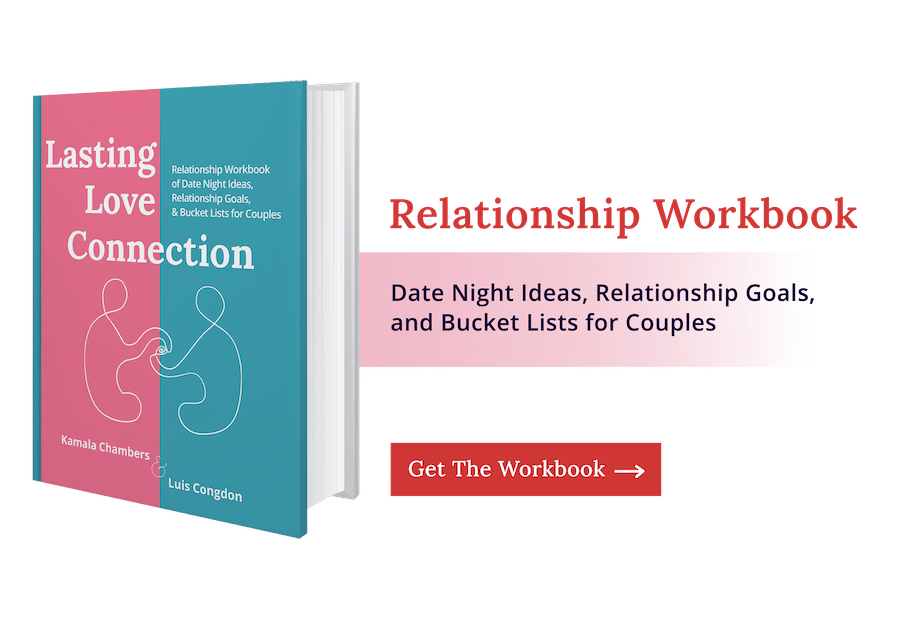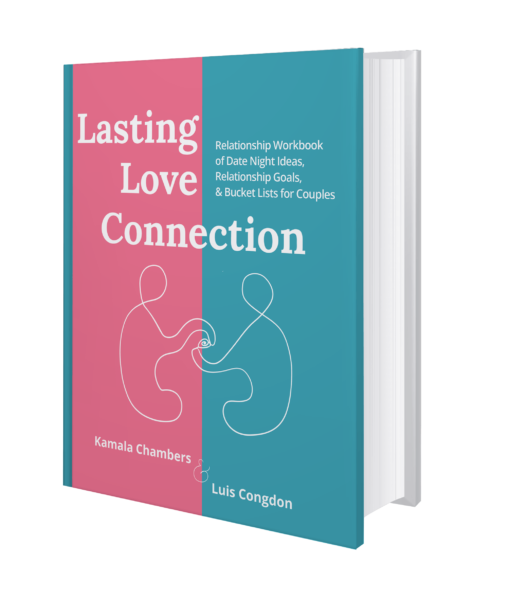Table of Contents
When you hear the words “compromising in relationships,” what do you think of?
Does compromise mean reluctantly giving up your desires to please your partner?
Or maybe you think about having the same arguments with your partner over and over again, with both of you refusing to budge.
Does compromising feel like losing, so issues don’t get resolved?
There has to be another way.
This article explores how compromising enhances your relationship and the common areas where compromises are often necessary.
Additionally, we outline five steps to help you compromise in relationships without feeling like you’re giving up what’s most important to you.
What is compromising in relationships?

When two people come together, they inevitably have different perspectives, preferences, and core values.
Can you recall when you and your partner insisted on having things your way? Suddenly, you forget you are a team and find yourselves standing on opposite sides, each desperate to be heard.
When neither of you is willing to budge and consider the other person’s point of view, arguments are bound to happen,
That is why compromise in a relationship is so important.
Compromise means talking through an issue, considering your partner’s perspectives, and finding a middle ground that works for both of you.
When you and your partner compromise, you leave the conversation feeling heard, understood, and more deeply connected.
Why is compromising in relationships important?
First, let’s examine the benefits of compromising in relationships.
Compromising in relationships promotes honest communication

You and your partner have to communicate your thoughts, feelings, and desires to reach a compromise.
If you often keep your opinions to yourself to avoid conflict, learning to compromise will break you out of this unhelpful pattern.
Through compromising, you gain a deeper understanding of each other, which leads to increased intimacy between you.
Compromising in relationships balances you and your partner’s needs
In a healthy relationship, you and your partner work together to meet your needs.
If one partner makes all the decisions, it can leave the other partner feeling neglected or unimportant.
This imbalance can lead to resentment and frustration over time, creating more serious relationship problems in the long run.
Compromising in relationships builds mutual respect and trust

Compromise in a relationship builds a strong foundation of mutual trust, as you feel comfortable bringing up concerns and working through them together.
When you make compromises, you and your partner feel assured that your preferences matter when making decisions.
You are committed to working together as a team to stop fighting and find solutions that work for both of you.
5 common areas for compromising in relationships
In the following examples, we’ll explore what compromising in relationships can look like.
Spending time together
Compromising is crucial, especially when it comes to spending time together.
You and your partner likely have different preferences on how often to spend quality time together and the activities you want to do for date nights.
On the other hand, you may prefer outdoor activities on weekends while your partner has different ideas on how to spend time off.
A reasonable compromise might be going on a short hike on Saturday and then watching movies together on Sunday to accommodate both of your needs.
Pick up the Date Night Workbook to find fun new ways to spend time together that you both enjoy.

Spending time with family

Navigating time with extended family often requires compromise in a romantic relationship.
This can get particularly challenging during the holidays.
What if you and your partner feel strongly about spending Thanksgiving with your families?
Here’s where compromise comes in.
To honor your and your partner’s wishes, you may choose to visit your partner’s family on Thanksgiving and yours on Christmas or alternate where you spend the holiday each year.
Splitting up household chores
Healthy relationships involve both partners sharing household responsibilities.
If one person does most of the work, it can lead to built-up resentment and frustration.
Finding a compromise can be as simple as discussing which chores you dislike most.
For example, if you dislike washing dishes but enjoy doing laundry, you may make an agreement with your partner to do the laundry in exchange for them doing the dishes.
This way, you contribute equally to accomplish chores and household tasks.
Finances

It is common for partners to have different perspectives when it comes to spending money.
For instance, one partner might spend money impulsively, while the other might prioritize saving for the future.
The best way to navigate these differences is to have an open conversation about your finances and set a budget that works for both of you.
This way, you’re on the same page about spending limits and how much money you need to save to meet your financial goals.
Finding a healthy compromise that works for both partners reduces the chances of later frustration or a serious fight.
Sex
Making compromises is also essential when it comes to sexual intimacy.
In many romantic relationships, it’s common for one partner to have a higher sex drive than the other.
Not addressing this gap may lead to feelings of rejection, frustration, and dissatisfaction with the relationship.
Therefore, take the time to talk about your sexual desires, preferences, and needs.
From there, you can meet halfway and discuss what it will take for both of you to feel connected and open to intimacy.
Kickstart this conversation with the Intimacy Workshop.

5 steps for compromising in relationships
Now, here are five practical steps to help you reach a compromise in a relationship.
Step #1 for compromising in relationships: Communicate your feelings

Start by choosing a time to talk without distractions.
When you sit down with your partner, effectively communicate your thoughts and feelings without blaming your partner.
For instance, you could say something along the lines of, “I have been feeling disconnected from you lately. Could we spend more time together in the evenings during the week?”
Step #2 for compromising in relationships: Listen to your partner’s perspective
Then, listen attentively to your partner’s feelings without judgment.
They may share that they often feel exhausted after work and require time alone to recharge.
Moreover, you can ask further questions to gain more understanding of your partner’s point of view.
Step #3 for compromising in relationships: Seek a middle ground

Now that you’ve voiced your need for time together and your partner’s need for time to themselves, you can start looking for common ground.
Brainstorm potential options that take into account both of your viewpoints.
Keep an open mind and be willing to adjust your initial request to accommodate your partner’s needs.
In this situation, you could consider the following suggestions for meeting halfway:
- You and your partner do your own thing after work, then reconnect for an hour before bedtime.
- Dedicate two evenings per week for spending time together and keep the remaining days for individual activities.
- Make eating dinner together a priority and then separate for personal time.
Sometimes, honoring your and your partner’s preferences may not be possible.
For example, if your partner wants to celebrate your anniversary at an Italian restaurant and you want to go to a Korean restaurant, it may not be feasible to go to both places.
In such situations, you may concede to what your partner wishes, knowing that you will choose the restaurant next time.
In a thriving relationship, there is an equal balance of give and take.
You value your partner’s happiness, and they consider yours.
If one person makes compromises constantly without reciprocation, they will likely feel cheated and resentful.
Step #4 for compromising in relationships: Evaluate your options

Once you identify potential solutions, discuss the pros and cons of each option.
After considering all the factors, decide on a solution that works for both of you.
Keep in mind that if the agreed-upon solution doesn’t work as expected, you can always revisit the conversation and make adjustments.
Step #5 for compromising in relationships: Seek support
If you and your partner are struggling to make compromises in your relationship, you don’t have to keep going around in circles on your own.
A marriage coach or licensed marriage and family therapist will give you the tools to navigate recurring conflicts and develop deeper understanding, respect, and intimacy amid your differences.
Book a complimentary couples consultation to see if working with us would be a good fit.
What is an example of compromise in a relationship?
When two people are in a relationship, there may be times when they have different preferences and opinions. One example of this is deciding where to go on vacation together. A compromise is needed if one person likes relaxing at the beach while the other prefers the city. In this situation, a compromise could mean splitting vacation days between beach time and exploring a nearby city. Alternatively, they could agree to visit the beach this time and plan to visit the city the following summer.
Why do people compromise in relationships?

Compromise in relationships avoids unnecessary conflicts and maintains a positive and supportive atmosphere. It demonstrates respect for each other’s feelings, opinions, and values, acknowledging that you and your partner have valid perspectives. Moreover, mutual concession prevents resentment or dissatisfaction when one person’s needs are always prioritized over the other’s.
How do you know if you’re compromising too much in a relationship?
In a healthy and happy relationship, there is an equal balance of give and take. If you constantly prioritize your partner’s happiness over your own, and you’re not receiving the same in return, you may be compromising too much. Other indications of over-compromising in romantic relationships include feeling like you’ve lost your individuality, harboring resentment, and declining mental health and well-being.
How do you deal with a partner who won’t compromise?
Dealing with a partner who refuses to compromise is challenging. To address this issue, take the following steps: 1. Communicate your feelings calmly and openly. Express how the lack of compromise is affecting you and the relationship. 2. Try to understand why your partner is reluctant to compromise and acknowledge their point of view. 3. Establish boundaries and find a balance that respects your needs and preferences. If the issue persists and you’re unable to find common ground, seek support from a mental health professional, like a licensed marriage and family therapist.






0 Comments